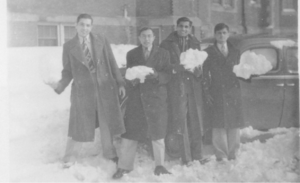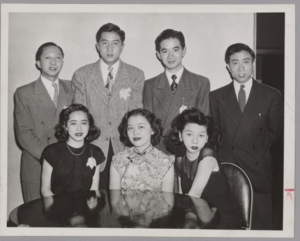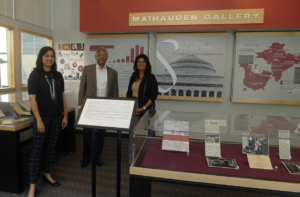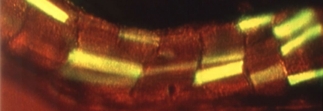
Indian Students at MIT, 1940. Photo courtesy of the Economic Times.
Asian Americans and Pacific Islanders have played a vital role in shaping America as we know it, contributing to every facet of industry, including higher education. Since 1990, the U.S. has used the month of May to recognize and celebrate Asians and Pacific Islanders in the United States. The Department of Distinctive Collections (DDC) celebrates Asian American and Pacific Islander (AAPI) Heritage Month and the many contributions AAPI people have contributed to the culture and history of MIT. Scholars, students, and staff from Asia and of Asian descent have been a part of the MIT community since the late 19th century.
In 1877, Cheong Mong Cham was the first student from China to matriculate at MIT. By 1910, China was sending more students to MIT than any other foreign country. In 1925, Li Fu Lee, a native of Hebei, became the first woman from China to attend MIT, enrolling as a mechanical engineering student. Nearly 2 decades later, Minghua Lee Wu became the first woman to receive a Ph.D. in Mechanical Engineering from MIT in 1948.
From these beginnings, the Institute became one of the most popular destinations for Chinese overseas students, many seeking to contribute to their country’s modernization through engineering, science, and commerce. Between 1877 and 1930, nearly 400 students from China attended MIT. These students played a key role in bringing new technology and science back to China during an era of rapid modernization, while also promoting American understanding of China and its people.
In 1882, Keshav Malhar Bhat, the first student from South Asia, came to MIT from Pune to study for one year. It would be 20 years before the next Indian student would be enrolled at MIT. Over the course of a century, several prominent Indians would study at the prestigious institute. Among the early pioneers, most would return and play an important part in making their home, in this case, India, a force to reckon with in the world of technology, a similar path to their Chinese counterparts.

Shan Fu Shen, president of MIT’s Chinese Students’ Club, 2nd from right. Published in The Boston Herald November 10, 1947. Photo courtesy of the MIT Museum.
Contemporarily the Institute is fortunate to have clubs, organizations, and initiatives that center AAPI history, in addition to academic and other programmatic offerings by DLCs and units across campus. One such offering in DDC is the Eiichiro Honma papers (MC-0721).
Eiichiro Honma (1853 – 1927) was the first student from Japan to earn a degree from MIT. In the student directory, his permanent address is listed as Fukuoka, Japan. He was sent by the Japanese government to Boston around 1867 and entered MIT in 1870, graduating in 1874 with an S.B. in Civil Engineering before being called home by the Japanese government in May 1874.
More recently, the 1996 video series, “It’s Intuitively Obvious,” created by the Office of Minority Education, is a recording of students in conversation about what it means to be a “minority” at MIT. Volume 2, titled “Asian Pacific American Students at MIT,” is available in the Annamaria Torriani-Gorini papers (MC-0702) and is also streamable on YouTube on the ICEO’s channel. In March 2023, The Asian American Initiative at MIT put together a zine titled “A Brief History of Asian American Advocacy at MIT.”
If you’re interested in learning more about these students or other Asian American and Pacific Islander experiences at MIT, we recommend looking at the Collection on Student Life at the Massachusetts Institute of Technology (MC-0618), MIT’s yearbook, the Technique (T171.M4257), and the Chinese Students Club newsletter (T171.M4241.C45a), all held in the Department of Distinctive Collections. The “It’s Intuitively Obvious” videos can be found online and in the Annamaria Torriani-Gorini papers (MC-0702).

Professor Sana Aiyar, Sudharkar Kesavan, ’84, Ranu Boppana, ’87 viewing Maihaugen Gallery’s current exhibit, South Asia and the Institute. Image courtesy of Jes Neal, DDC.
The Maihaugen Gallery’s current exhibit, South Asia and the Institute, examines the experiences of South Asian students and faculty at MIT and is open through October 13, 2023. The Maihaugen Gallery is open daily and is located in 14N-130.
Quick Facts from DDC
Some of MIT’s first Asian students included:
- Eiichiro Honma (Japan, class of 1874, Course 1), the first international student to graduate from the Institute
- Keshar Melhar Bhat, the first South Asian student, was enrolled in course V for the 1882-83 school year
- Mon Cham Cheong, or Zhang Wenzhan, (Course II, class of 1883) was the first Chinese student
- Kiyo Makino (Course VII, class of 1905) became the Institute’s first female international student, hailing from Japan
- Li Fu Lee, or Lǐ Lìfú, (Course VI, class of 1929) was the first Chinese woman to enroll
- Amar Gopal Bose (Course VI, class of 1951) became the first South Asian-American undergraduate student in 1947 and in 1955 became MIT’s first South Asian faculty member.
Other early Asian faculty include:
- Hsue-Shen Tsien (or Qian Xuesen), who became a tenured professor in Aeronautical Engineering in 1947
- Koichi Masubuchi, who was granted tenure in Ocean Engineering in 1971
- Prabha Iyengar Sridharan became the first South Asian woman on MIT’s faculty in 1973 as an Associate Professor in Mechanical Engineering
- Richard K. Yamamoto was tenured in Physics in 1975
- ChoKyun Rha was the first woman of Asian descent to become tenured faculty at MIT in 1980.
As we celebrate this month, DDC would like to recognize and thank our Asian American and Pacific Islander students, faculty, and staff, as well as our international students from Asian and Pacific islands and countries, for their contributions and achievements to the MIT community and beyond.
